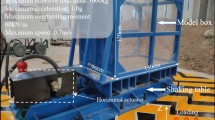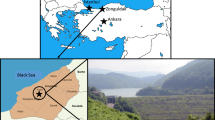Abstract
Seismic performance and the dynamic deformation mode of a slope with a weak intercalated layer (WIL) under earthquake excitations are very important for suitable seismic design of certain structures. In southwestern China, near the Longmenshan Fault, the dynamic response of slopes triggered by earthquakes is still not well understood. In this study, a series of dynamic centrifuge model tests under a 50-g hypergravity treatment with different input seismic motions were performed to investigate the effect of the input motion on the dynamic behavior of the WIL slope. The test results indicate that the amplification factors of the acceleration response increased with increasing height of the slope, reaching maximum values at the crest and the top surface, but abrupt changes in amplification with increasing height occurred at the WIL. The acceleration amplification at the WIL was related to the peak of the input motion. The amplification factor at the intercalated layer was weakened when the peak of input acceleration was equal to or less than 0.15 g, but it increased when the input peak was greater than 0.15 g. Acceleration amplification at the WIL was affected by the slope structure effect.


















Similar content being viewed by others
References
Assimaki D, Gazetas G, Kausel E (2005) Effects of local soil conditions on the topographic aggravation of seismicmotion: parametric Investigation and recorded field evidence from the 1999 Athens earthquake, Bull Seismol Soc Am 95(3):1059–1089
Chen Y, Han C, ling D, Kong L, Zhou Y (2011) Development of geotechnical centrifuge ZJU400 and performance assessment of its shaking table system. Chin J Geotech Eng 33:1887–1894 (in Chinese)
Chen X, Zhou B, Ran H, Min W, Zhou Q (2015) Influence of rock masses properties on the slope stabilities: a study based on slope failures during the 2008 Wenchuan earthquake. Eng Geol Soc Territory 2:1219–1223
Craig WH (1983) Simulation of foundation for offshore structure using centrifuge modelling. In: Banerjee PK (ed) Developments in Soil and Foundation Engineering—Model Studies. Elsevier, London, pp 1–27
Ding Y, Dang C, Yuan G, Wang Q (2012) Characteristics and remediation of a landslide complex triggered by the 2008 Wenchuan, China earthquake—case from Yingxiu near the earthquake epicenter. Environ Earth Sci 67:161–173
Fan G, Zhang J, Fu X, Zhou L (2016a) Dynamic failure mode and energy-based identification method for a counter-bedding rock slope with weak intercalated layers. J Mt Sci 13:2111–2123
Fan G, Zhang J, Wu J, Yan K (2016b) Dynamic response and dynamic failure mode of a weak intercalated rock slope using a shaking table. Rock Mech Rock Eng 49:3243–3256
Huang R, Li W (2009) Analysis of the geo-hazards triggered by the 12 may 2008 Wenchuan earthquake. Chin Bull Eng Geol Environ 68:363–371
Huang R, Zhao J, Ju N, Li G, Lee ML, Li Y (2013) Analysis of an anti-dip landslide triggered by the 2008 Wenchuan earthquake in China. Nat Hazards 68:1021–1039
Lin M, Wang K (2006) Seismic slope behavior in a large-scale shaking table model test. Eng Geol 86:118–133
Liu H, Xu Q, Hou H (2013a) Influence of lithology and rock structureon slope seismic acceleration responses. Rock Soil Mech 34:2482–2488. (in Chinese)
Liu H, Xu Q, Li Y, Fan X (2013b) Response of high-strength rock slope to seismic waves in a shaking table test. Bull Seismol Soc Am 103:3012–3025
Liu H, Xu Q, Li Y (2014) Effect of lithology and structure on seismic response of steep slope in a shaking table test. J Mt Sci 11:371–383
Liu H, Xu Q, Zhou F, Yang Z, Wang F (2015) Shaking table test for seismic responses of slopes with a weak interlayer. Chin J Rock Mech Eng 34:994–1005. (in Chinese)
Rizzitano S, Cascone E, Biondi G (2014) Coupling of topographic and stratigraphic effects on earthquake response of slopes through 2D linear and equivalent linear analysis. Soil Dyn Earthq Eng 67:66–84
Srilatha N, Madhavi Latha G, Puttappa CG (2013) Effect of frequency on seismic response of reinforced soil slopes in shaking table tests. Geotext Geomembr 36:27–32
Stockwell RG, Mansinha L, Lowe RP (1996) Localization of the complex spectrum: the S transform. IEEE Trans Signal Process 44:998–1001
Wang K, Lin M (2011) Initiation and displacement of landslide induced by earthquake—a study of shaking table model slope test. Eng Geol 122:106–114
Wang L, Zhang G (2014) Centrifuge model test study on pile reinforcement behavior of cohesive soil slopes under earthquake conditions. Landslides 11:213–223
Wang J, Yao L, Arshad H (2010) Analysis of earthquake-triggered failure mechanisms of slopes and sliding surfaces. J Mt Sci 7:282–290
Xiao S, Feng W, Zhang J (2010) Analysis of the effects of slope geometry on the dynamic response of a near-field mountain from the Wenchuan earthquake. J Mt Sci 7:353–360
Xu C, Xu X (2014) The spatial distribution pattern of landslides triggered by the 20 April 2013 Lushan earthquake of China and its implication to identification of the seismogenic fault. Chin Sci Bull 59(13):1416–1424
Xu G, Zhang W (1996) Study of grain size effect and boundary effect in centrifugal model. Chin J Geotech Eng 18:80–86. (in Chinese)
Yu Y, Deng L, Sun X, Lu H (2008) Centrifuge modeling of a dry sandy slope response to earthquake loading. Bull Earthq Eng 6:447–461
Zhang Z, Wang T, Wu S, Tang H, Liang C (2017a) Seismic performance of loess-mudstone slope by centrifuge tests. Bull Eng Geol Environ 76:671–679
Zhang Z, Wang T, Wu S, Tang H, Liang C (2017b) Seismic performance of loess-mudstone slope in Tianshui-centrifuge model tests and numerical analysis. Eng Geol 222:225–235
Acknowledgements
The authors gratefully acknowledge the financial support of the Key Program of the National Natural Science Foundation of China (Grant No. 41530639 and 51708163) and the Cultivation Program for Excellent Doctoral Dissertation of Southwest Jiaotong University (Grant No. D-YB201702). The technical support of the Key Laboratory of Soft Soil and Environment Engineering, Ministry of Education, Zhejiang University is also appreciated.
Author information
Authors and Affiliations
Corresponding author
Rights and permissions
About this article
Cite this article
Yan, K., Zhang, J., Cheng, Q. et al. Earthquake loading response of a slope with an inclined weak intercalated layer using centrifuge modeling. Bull Eng Geol Environ 78, 4439–4450 (2019). https://doi.org/10.1007/s10064-018-1421-4
Received:
Accepted:
Published:
Issue Date:
DOI: https://doi.org/10.1007/s10064-018-1421-4




